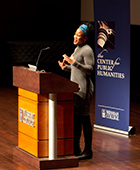Resilience, sustainability and the humanities: Majora Carter encourages community development and resiliency
 “True resiliency is not about surviving; it’s about thriving,” said Majora Carter during Messiah College’s annual Humanities Symposium Feb. 26-28. Carter, an urban revitalization strategist and keynote speaker for the symposium, spoke about the idea of resiliency and community development, and their positive implications on society. A South Bronx native, Carter has a passion for creating social cohesion and economic diversity in underdeveloped communities. Her dreams have created amazing realities for many people in the South Bronx and beyond.
“True resiliency is not about surviving; it’s about thriving,” said Majora Carter during Messiah College’s annual Humanities Symposium Feb. 26-28. Carter, an urban revitalization strategist and keynote speaker for the symposium, spoke about the idea of resiliency and community development, and their positive implications on society. A South Bronx native, Carter has a passion for creating social cohesion and economic diversity in underdeveloped communities. Her dreams have created amazing realities for many people in the South Bronx and beyond.
To Carter, social cohesion rests at the heart of every issue in sustainable community development. In her address, Carter outlined four steps necessary to create social cohesion and to accomplish goals that enact substantial change: identify a target market, identify policy needs, design an attractive solution to the proposed need and launch the “beta version” of the project. In Carter’s words, “you have to actually do something.”
Carter demonstrated positive outcomes of social cohesion by taking the audience through several revitalization projects she helped lead in her hometown of Hunts Point as the executive director of Sustainable South Bronx.
Her first major project was refining Hunts Point Riverside Park in 2006. She and a team took this previously unusable waterfront property and beautified it into a useful park for the community’s children and families.
Another revitalization project to Hunts Point came through the New York City Economic Development Corporation. After recognizing the market need for safer streets and economic growth, the corporation issued the Hunts Point Vision Plan which Carter has played a major role in implementing. She and the team began creating plans for Greenway, a linear park connecting the Hunts Point community to larger parts of the South Bronx, providing better access to the waterfront, improving transportation safety and enhancing the bike and pedestrian paths on the South Bronx peninsula, all while providing opportunities for economic development through access to increased resources. This project is expected to be completed early in 2015.
Through these projects, Carter saw job creation as another market need. Storeowners and those who needed workers hired outside Hunts Point, disregarding the capable people in the local community. Alongside the Bronx Environmental Stewardship Training program, Carter came up with a job training placement program intended to teach residents useful ecological skills, such as how to decontaminate water, so they could sustain themselves and work. This greatly improved employment levels; by 2008, 85 percent were employed and 10 percent attended college.
To further grow the economy, Carter wanted to extended job creation and educational opportunities to community youth. She helped a team of 10 teens redesign the entrance into their community, a railroad building, making them feel like a productive part of a positive change in their neighborhood.
In schools, Carter and others helped prepare students for future job opportunities by teaching them hands-on skills like coding. Kids were taught how to code their own video games, using something they loved to do to make them active members of society. The project was a success and the kids learned adequate skills to get entry-level tech jobs.
Summarizing her lecture, Carter concluded that creating economic diversity will move humankind into a much more socially responsible world and will fuel ethical economic and community growth. She believes those who love justice should concentrate on empowering people, whether children or adults, by training them to be active participants in a productive economic cycle instead of trying to “put Band-Aids” on them. Carter emphasized that we have to create these types of opportunities to get a vibrant, long-term street and pedestrian culture. With a love for people and the ambition to do great things, Carter concluded: “How do we show that all this is a possibility? We do it by trying.”
Story by Katie Johnson ’15, photo courtesy of Jonathan Isaac ’17




